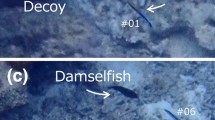Abstract.
Most blennioid fishes show a resource-based, promiscuous mating system with alternative 'sneaking' mating tactics. The hole-nesting species, Aidablennius sphinx, however, appears to be an exception; small males did not mimic females, most had their own nest and not once in 20 h of spawning observations did a second male enter a nest. In this field study, we ask if sneaker tactics are constrained and what factors favour independent nesting by small males. Larger males received more eggs sooner and attracted more females than smaller males. Larger males may be preferred because they released more sperm per ejaculation and fanned their eggs more often. In the long-term, however, larger males did not spawn more often than smaller males since: (1) the nests of large males filled up with eggs sooner than the nests of small males; (2) large males refused females more often than small males; and (3) a highly biased ratio of females to preferred large males meant many females had no option but to spawn with small males. Thus, small males nest independently, despite potential for female mimicry tactics (multiple females spawned simultaneously) and simultaneous parasitic spawning (males exited the nest during spawning)
Similar content being viewed by others
Author information
Authors and Affiliations
Additional information
Electronic Publication
Rights and permissions
About this article
Cite this article
Neat, F.C., Locatello, L. No reason to sneak: why males of all sizes can breed in the hole-nesting blenny, Aidablennius sphinx . Behav Ecol Sociobiol 52, 66–73 (2002). https://doi.org/10.1007/s00265-002-0481-3
Received:
Revised:
Accepted:
Issue Date:
DOI: https://doi.org/10.1007/s00265-002-0481-3




